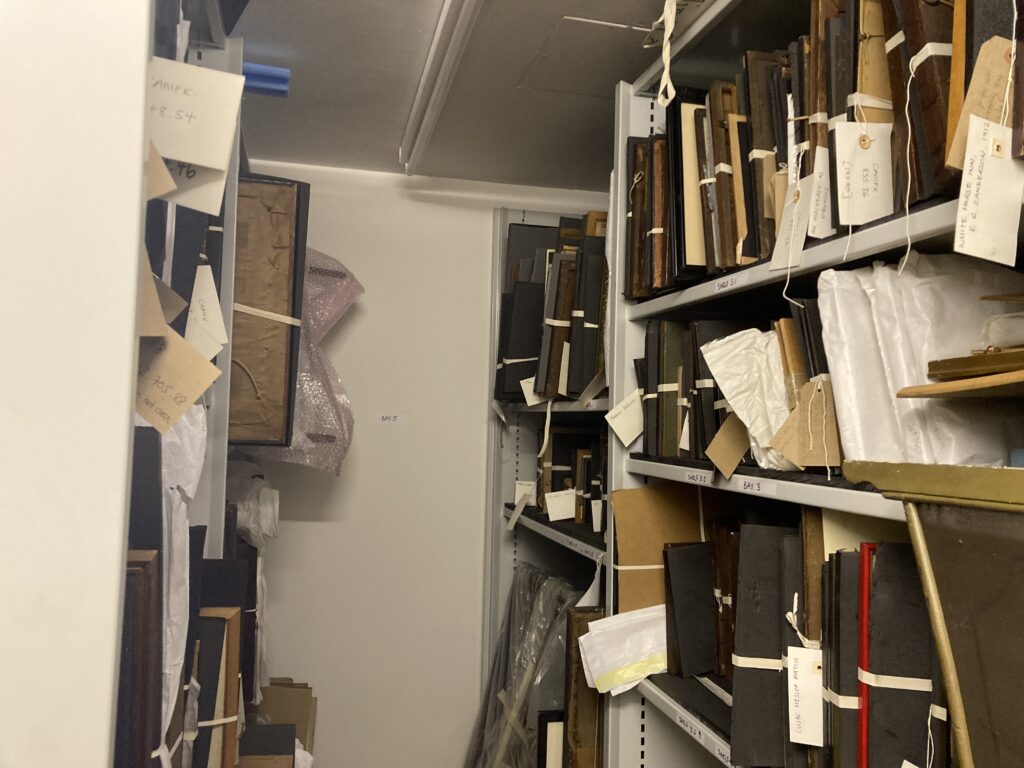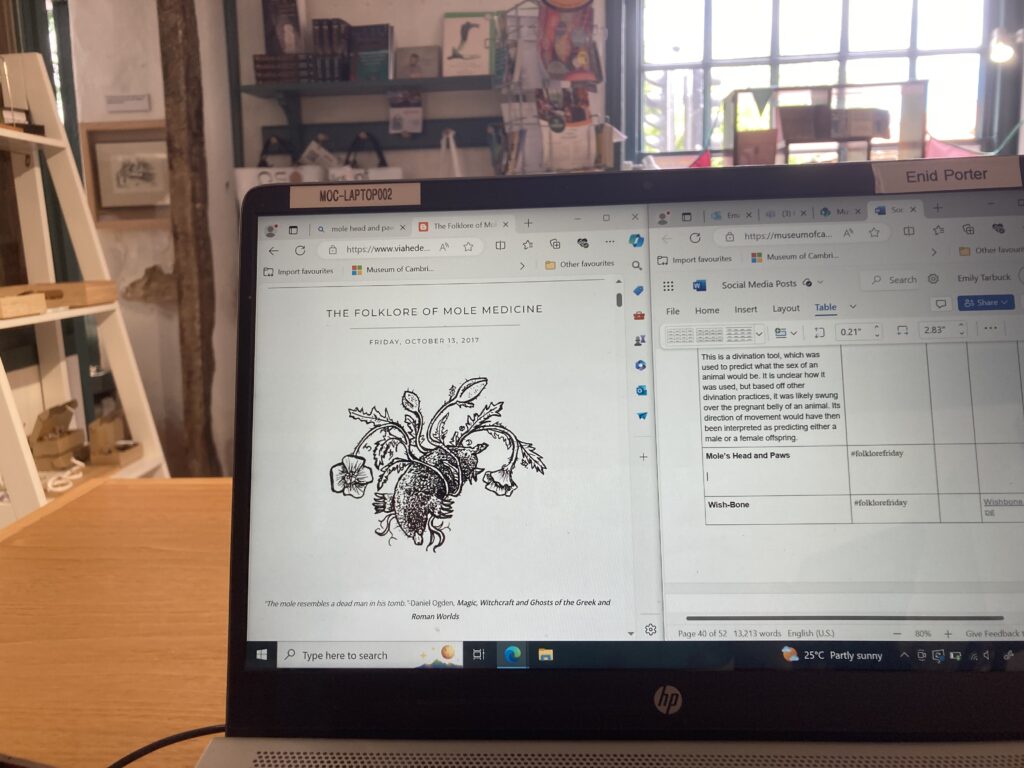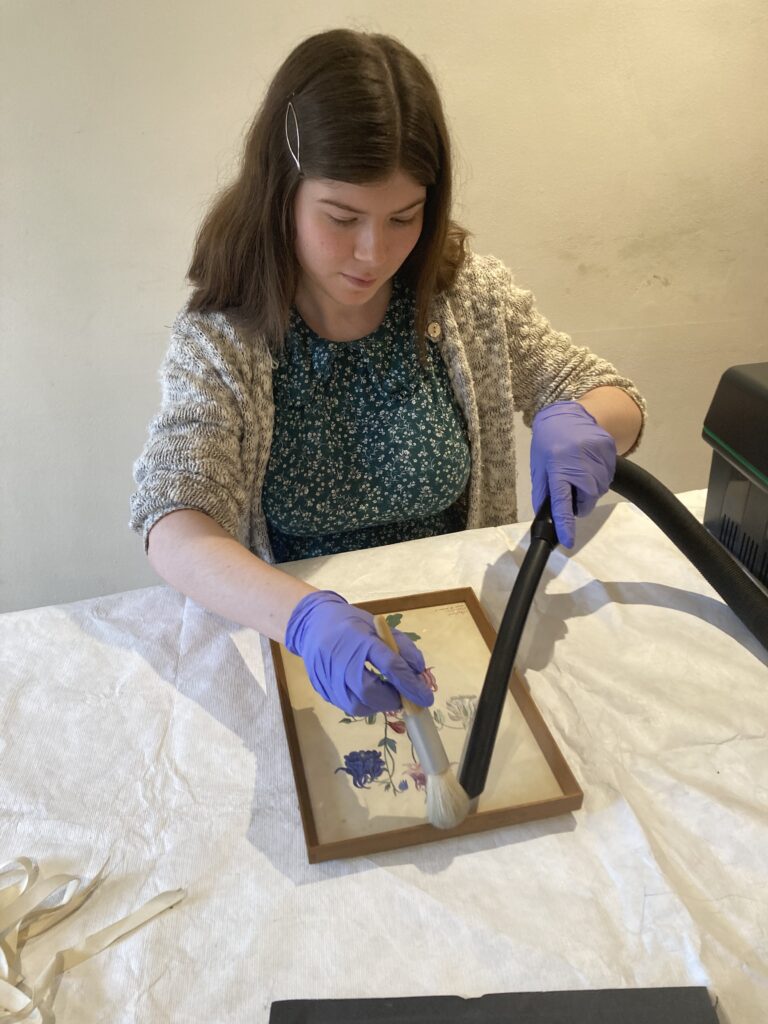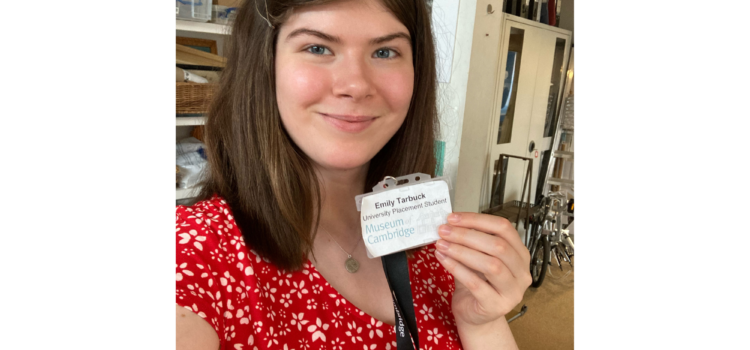Hear From Emily, who did a university placement with the Museum of Cambridge, about her experiences and reflection of her time with us!
I first visited this lovely little museum around a year ago, when I’d stopped off in Cambridge to pay a short visit to a friend. The friendly welcome, building clearly steeped in history (uneven floorboards and all!) and fascinating objects around every corner really called my name. When I stepped through from the Dining Room and found myself met with a room filled with various objects from English folklore – a particular fascination of mine – I was completely sold. The Museum of Cambridge lingered in my mind for next year, and when I had the opportunity to do a placement as part of my Museum Studies course at Durham University, this was top of my list!
My name’s Emily and, as mentioned, I’m currently doing an MA course up in Durham. I’ve just finished a month-long placement here as part of this, and I’d love to share some of what I’ve been doing to give you a real behind-the-scenes look at the museum.
Much of my previous volunteering experience has been in small, local museums like this one, so I was familiar with the idea that everybody does a bit of everything in these kinds of places. This was another reason I wanted to do my placement here, as I’m aiming to go into the heritage industry and want to build up as much experience as I can of how all the different parts of museums and heritage sites work. I’ve certainly been able to do that during my time here, and I was given plenty to keep me busy!
The main project I worked on over the four weeks was writing social media posts for the museum. These included posts celebrating various holidays, ones about the different objects available on the Adopt-an-Object scheme and restarting the #folklorefriday series about the various fascinating and unusual objects in the folklore collection.

Researching, writing and photographing for the holiday posts was a larger project than I was expecting, but I had a lot of fun doing it. Once I had been trained in how to safely handle the museum collection, being able to go down to the stores and find various historical objects all on my own was one of my favourite things to do. For this part of my social media project, I made a list of different holidays or annual events which I thought would appeal to our followers. These ranged from the expected, such as Christmas and Easter, to local events which people might not have heard of before, including Ely Eel Day, and even dates specific to the museum, such as the birthday of the longest-serving curator, Enid Porter.
Once I had these dates, I could get to the really fun part – diving into the collection itself. Using the collection database, MODES, I researched these different holidays to see if there were any objects here that related to them, and I made some fascinating connections. Some of my personal favourites included a photograph of the museum’s opening back in 1936, for International Museums Day, three medals issued to a Private Palmer during World War Two, for Remembrance Day, and the man trap on display in our Fen & Folklore Room as a slightly cheeky Valentine’s Day post!

The museum’s Adopt-an-Object scheme lets you sponsor an object on display that’s taken your fancy, and the current aim is to expand the number of items that are advertised as being up for adoption (See more here: Adopt an object today and help preserve Cambridgeshire’s heritage for centuries to come – The Museum of Cambridge). This is where I came in, as I was able to select and research objects which I thought had interesting stories behind them and would attract new donors. I was able to experiment with a different style and tone in these posts, as the website copy has traditionally been written from the perspective of the objects, which was great fun to do. Bringing the idea of ‘if only objects could talk’ to life was a new way of engaging with museum collections for me, and I’d love to take this concept with me to the next museum I end up in. Keep a look out for some talking objects on the Museum of Cambridge social media in the near future. A pram, a bed-bug trap, and even a foot-operated dentist’s drill – we’ve got it all here!
As I mentioned earlier, the folklore collection was one of the main things that drew me to this museum, as I’ve always had a fascination for this kind of thing. So, I’ve thoroughly enjoyed exploring the various boxes filled with weird and wonderful objects in the folklore cabinet. Here are just a few different things to give you an idea: a wish bone, snakestone, witch ball, and even a mummers’ sword. I’m not telling you what they all are just yet though – you’ll have to read my blogs to find out more…

Aside from social media, I have also spent a lot of time on the front desk, welcoming visitors in and getting to know the museum better from their point of view. It’s amazing how much more you can learn about the place you’re working in by seeing it from the visitors’ point of view, and I’ve also had some lovely chats whilst working there, learning all about people’s memories of Cambridge and how it has changed over the years.
The collections volunteering at the museum currently involves cleaning and packaging framed pictures in the store, which I’ve been taking part in. Here I am, hard at work! I’ve been looking to increase my knowledge and experience of collections care, so this was a lovely opportunity to do just that and get up close and personal with some gorgeous pieces (luckily, I didn’t run into any mould this time)! These objects are cleaned by using a brush made of goat’s hair to gently move any dust and dirt into the museum vacuum. We then packaged them by securing them to a piece of plastazote, which is a type of foam specifically designed to protect the fragile parts from becoming damaged.

Finally, and perhaps one of the most exciting things I’ve been working on, is a handbook for the Community Curation Cabinet. This is a case in the Dining Room upstairs, which is going to be available for various local groups to design and display their own temporary exhibitions in, telling the story of Cambridge that they want visitors to see. I’ve always been very interested in these kinds of community projects within museums, and as I recently curated my first ever exhibition as part of my masters course, I was in the perfect position to create a guide for people who want to put up a museum display but have no idea where to start. Helping to make this less intimidating, and letting more local Cambridge stories be told, is something I’m very proud to be taking part in.
Overall, I’ve had a lovely time here at the Museum of Cambridge, and I’ll definitely be popping in to visit next time I’m in the area. I’d like to thank Alex, Sum Yin, Annie, Beau, Alex, Julia, Roger, and the rest of the staff, volunteers and trustees for helping me to settle in so well and get lots more museum experience. Best of luck for the future!
